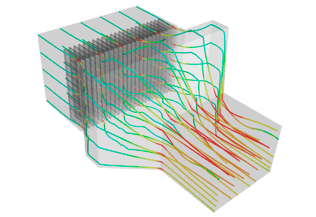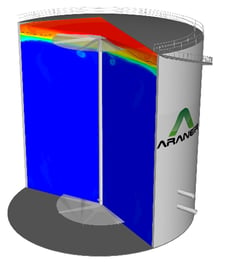Managing cooling energy through Computation Fluid Dynamics (CFD) Analysis is an effective way to carry out power plants at the highest levels of efficiency. Old times, engineers relied merely on experience to develop the aerodynamic aspects of their designs. Later, they would resort to tunnels, but the process remained expensive and time-consuming. Ever since Computational Fluid Dynamics (CFD) emerged in the early 1930s , many industries have made leaps and bounds and numerous innovations have emerged. The flexibility, affordability, and precision of this technology have seen ARANER apply it in TIAC designs to the satisfaction of users.
Basics of Computational Fluid Dynamics Analysis
Computational Fluid Dynamics (CFD) is a concept of predicting the quantitative result of a fluid flowing, especially under the simultaneous influence of mechanical movement, mass transfer, heat flow and chemical reaction among other factors. This tool is already well established in leading industries with applications such as predictive pollution control and aerodynamic design. Computational Fluid Dynamics (CFD) represents a key tool in the design, development, and implementation of ARANER technologies by adding a superior understanding and insight into these critical physical phenomena. CFD-based design using the last advances in High-Performance Computing (HPC) enables ARANER engineers to assess and optimize the configurations of tailor-made projects. CFD simulations are essential to design solutions but, most importantly, to ensure beforehand that the systems satisfy the expected requirements of the project.
The Secret of Computational Fluid Dynamics
Computational fluid dynamics are based on the Navier-Stokes equations which describe the fluid flow . These equations explain how the velocity, pressure, temperature, and density of a moving fluid are related. The equation, also called the momentum equation, is found by applying Newtons' Second Law of motion, force is equal to mass times acceleration (F=ma), to a fluid element. The Navier-Stokes equation must be used in conjunction with the continuity equation which accounts for the mass conservation of flow, and the energy equation which accounts for the conservation of energy; the equations together are often referred to as the Navier-Stokes Equations. They are partial differential equations that describe the balance of the forces at a given point within a fluid. In particular, the investigation of fluid flow with thermal changes depends on simultaneously solving the equations for velocity, pressure, and temperature. However, the final form of the Navier-Stokes equations also contains four other thermodynamic variables; density, enthalpy, viscosity, and thermal conductivity. The use of additional variables allows the computer to use the known physical properties of the fluid, the geometry of the system, and the boundary conditions to solve the equations for the entire system and across a given period of time, usually a one-day temperature cycle in the case of TES. The result is a true indication of how a system can be expected to function, telling us such important factors as how long it will take for the stored thermal energy to be fully utilized.
FILTER-HOUSE OPTIMIZATION
When looking for power augmentation, turbine inlet air cooling is quickly becoming the best-considered solution. TIAC allows energy output to increase with no need to invest in new or more powerful gas turbines . Industrial TIAC solutions, such as the ones designed and manufactured by ARANER, are usually tailor-made to fit into the existing technology. However, some adaptations are occasionally needed. The modification of the filter-house is normally one of them. I f you are planning to draw on a turbine inlet air cooling system, you will need to be ready to make some modifications to the filter-house of your power generation technology. Usually, the filter-house will admit a certain air volume which will match the volume the very one the gas turbine can also take. The air density after cooling (downstream the filters) is much higher. Because of the mass conservation principle, the air volume flow passing the air filters is increased. If we want to avoid an increase in the pressure drop or any disturbance in the flow, filter-house modification might be required. Computation Fluid Dynamics is always advisable to check the airflow performance.
 Figure 1: Detailed analysis of the FilterHouse Modification
Figure 1: Detailed analysis of the FilterHouse Modification
When working on these modifications, and to guarantee the reliability, ARANER uses Computational Fluid Dynamics (CFD) analysis . This system allows efficient simulation of airflow through the entire turbine system, including both the filter-house and the TIAC technology. This flow analysis, previous to implementation, measures how air density changes through the cooling process, making sure that the volume going in the modified filter-house is equivalent to the one the turbine will be able to take after cooling, achieving therefore great performance. Along with CFD, at ARANER we have developed our own tool to simulate the performance of the TIAC plant, which contemplates factors such as real weather conditions and gas turbine parameters.
THERMAL ENERGY STORAGE (TES) AND DIFFUSERS
Thermal Energy Storage (TES) tank is a thermal accumulator that allows the storage of cooling produced during an off-peak time, thus reducing the operational cost and the required capacity of the TIAC plant. The chilled water supplements the chiller, covering for the time that the demand is high, the chiller is restarting or power failure. TES is available in two concepts namely partial storage and full storage, each with its advantages and disadvantages.
 Figure 2: Detailed analysis of the thermocline formation during the discharging phase of a Thermal Energy Storage tank
Figure 2: Detailed analysis of the thermocline formation during the discharging phase of a Thermal Energy Storage tank
For simplicity and low-cost reasons, natural stratification is the most popular system. In this case, gravity separates the water, with the warmer (less dense) water settling at the top and the colder (denser) water at the bottom. Stratified chilled water Thermal Energy Storage tank comprises two sets of water distribution; one at the bottom and another at the top. Between these two distributors appears a non-physical boundary layer that is popularly known as the thermocline. These sections hold water at different temperatures. Storage capacity depends on the temperature difference, whereby a higher temperature difference yields higher storage capacity for a given water volume. However, thermocline in the natural stratification setup is at risk of destruction by water outputs and feed-ins in case of improper design/ omission of CFD analysis , since the design of the diffusers affects the performance of a TES in TIAC applications. These components play a critical role during both charging and discharging processes. Without diffusers, it would be difficult to achieve stratification at the desired flow rate. CFD comes in handy as a reliable tool for unique designs. Discover our 1-minute video of a CFD simulation in a TES Tank.
DESIGN PROCESS BY ARANER
Why is it so important to use this tool? The basis of this approach is the fact that every customer comes with unique needs. To get the exact conditions, the designed must be subjected to real conditions, thus testing its performance before the erection is strongly advised. Poor designs are a recipe for a system that does not meet requirements. Customers may not get the cooling capacity needed. The application of ARANER’s CFD tools is the surest way of getting optimum performance from the project. Any omissions or mistakes in the project are rectified early to avoid money and time losses. Computational Fluid Dynamics enables ARANER engineers to optimize the configurations of our state-of-the-art solutions and increase the performance of the projects. This simulation software enables engineers to ensure successful product development. By using the computational fluid dynamics approach, ARANER is able to confirm product conformity to client requirements early in the initial stages of the design project.










